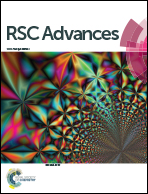Self-healing of thermally molded commodity plastics based on heat-resistant and anti-aging healing systems†
Abstract
Herein, to prepare an extrinsic self-healing system with high heat resistance to tolerate the processing of thermoplastics, a group of new healants based on atom transfer radical polymerization is developed. It consists of microencapsulated acrylate monomers (2-methyl-2-adamantylmethacrylate or trimethylolpropane trimethacrylate), macroinitiator poly(methyl methacrylate)–Br, and supported catalyst (coordination compound of cyclic 5,5,7,12,12,14-hexamethyl-1,4,8,11-tetraazacyclotetradecane and cuprous bromide). Composites containing the healing agent with polystyrene, poly(methyl methacrylate) and acrylonitrile-butadiene-styrene copolymer as matrices were successfully manufactured by compression molding. Impact tests indicate that the composites can regain their mechanical strength as a result of polymerization of the released acrylate monomers at room temperature. The strong interaction between the cyclic ligand and CuBr obviously enhances the thermostability of the ligand and depresses the negative influence of cupric ions on the aging properties of the matrix polymers. The present work offers a new route for the design and application of self-healing thermoplastics.


 Please wait while we load your content...
Please wait while we load your content...